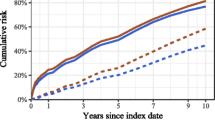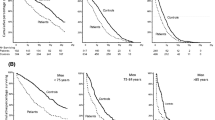Abstract
Summary
We wanted to study mortality after hip fractures among elderly women in Norway. We found that excess mortality was highest short time after hip fracture, but persisted for several years after the fracture. The excess mortality was not explained by pre-fracture medical conditions.
Introduction
The purpose of the present study was to investigate short and long term mortality after hip fracture, and to evaluate how comorbidity, bone mineral density, and lifestyle factors affect the survival after hip fractures.
Methods
The study cohort emerges from a population-based health survey in the county of Nord-Trøndelag, Norway. Women aged 65 or more at participation at the health survey who sustained a hip fracture after attending the health survey are cases in this study (n = 781). A comparison cohort was constructed based on participants at HUNT 2 with no history of hip fractures (n = 3, 142). Kaplan–Meier survival curves were used to evaluate crude survival, and Cox regression analyses were used to study age-adjusted hazard ratios for mortality and for multivariable analyses involving relevant covariates.
Results
Mean length of follow-up after fracture was 2.8 years. Within the first 3 months of follow-up, 78 (10.0%) of the hip fracture patients died, compared to only 39 (1.7%) in the control group. HR for mortality 3 months after hip fracture was 6.5 (95% CI 4.2–9.6). For the entire follow-up period women who sustained a hip fracture had an HR for mortality of 1.9 (95% CI 1.6–2.3), compared with women without a hip fracture.
Conclusions
We found that elderly women who sustained a hip fracture had increased mortality risk. The excess mortality was highest short time after the fracture, but persisted for several years after the fracture, and was not explained by pre-fracture medical conditions.

Similar content being viewed by others
References
Ahmed LA et al (2006) Validation of the Cummings’ risk score; how well does it identify women with high risk of hip fracture: the Tromso Study. Eur J Epidemiol 21(11):815–822
Kanis JA et al (2000) Long-term risk of osteoporotic fracture in Malmo. Osteoporos Int 11(8):669–674
Fitts WT et al (1959) Life expectancy after fracture of the hip. Surg Gynecol Obstet 108:7–12
Jitapunkul S, Yuktanandana P (2000) Consequences of hip fracture among Thai women aged 50 years and over: a prospective study. J Med Assoc Thai 83(12):1447–1451
Farahmand BY et al (2005) Survival after hip fracture. Osteoporos Int 16(12):1583–1590
Petersen MB et al (2006) Factors affecting postoperative mortality of patients with displaced femoral neck fracture. Injury 37(8):705–711
Forsen L et al (1999) Survival after hip fracture: short- and long-term excess mortality according to age and gender. Osteoporos Int 10(1):73–78
Haentjens, P., et al., Meta-analysis: excess mortality after hip fracture among older women and men. Ann Intern Med. 152(6): 380–390
Empana JP, Dargent-Molina P, Breart G (2004) Effect of hip fracture on mortality in elderly women: the EPIDOS prospective study. J Am Geriatr Soc 52(5):685–690
Magaziner J et al (1997) Excess mortality attributable to hip fracture in white women aged 70 years and older. Am J Public Health 87(10):1630–1636
Cauley JA et al (2000) Risk of mortality following clinical fractures. Osteoporos Int 11(7):556–561
Robbins JA, Biggs ML, Cauley J (2006) Adjusted mortality after hip fracture: From the cardiovascular health study. J Am Geriatr Soc 54(12):1885–1891
Wolinsky FD, Fitzgerald JF, Stump TE (1997) The effect of hip fracture on mortality, hospitalization, and functional status: a prospective study. Am J Public Health 87(3):398–403
Tosteson AN et al (2007) Excess mortality following hip fracture: the role of underlying health status. Osteoporos Int 18(11):1463–1472
Holmen J, Midthjell K, Kruger O, Langhammer A, Holmen TL, Bratberg G, Vatten L, Lund-Larsen P (2003) The Nord-Trondelag Health study 1995–97 (hunt 2): objectives, contents, methods and participation. Norsk Epidemiologi 13(1):19–32
Forsmo S et al (2006) What is the influence of weight change on forearm bone mineral density in peri- and postmenopausal women? The health study of Nord-Trondelag, Norway. Am J Epidemiol 164(9):890–897
Forsmo S et al (2005) Forearm bone mineral density in an unselected population of 2,779 men and women–the HUNT Study, Norway. Osteoporos Int 16(5):562–567
Forsmo S et al (2001) How do reproductive and lifestyle factors influence bone density in distal and ultradistal radius of early postmenopausal women? The Nord-Trondelag Health Survey, Norway. Osteoporos Int 12(3):222–229
Meyer HE et al (2000) Factors associated with mortality after hip fracture. Osteoporos Int 11(3):228–232
Magaziner J et al (1989) Survival experience of aged hip fracture patients. Am J Public Health 79(3):274–278
Pioli G et al (2006) Predictors of mortality after hip fracture: results from 1-year follow-up. Aging Clin Exp Res 18(5):381–387
Johansson C et al (1998) Bone mineral density is a predictor of survival. Calcif Tissue Int 63(3):190–196
Browner WS et al (1991) Non-trauma mortality in elderly women with low bone mineral density. Study of Osteoporotic Fractures Research Group. Lancet 338(8763):355–358
Giversen IM (2007) Time trends of mortality after first hip fractures. Osteoporos Int 18(6):721–732
Acknowledgements
Nord-Trøndelag Health Study (The HUNT Study) is a collaboration between HUNT Research Centre, Faculty of Medicine at the Norwegian University of Science and Technology (NTNU, Verdal), Norwegian Institute of Public Health and Nord-Trøndelag County Council.
Conflicts of interest
Arnulf Langhammer is joint owner of a DXA bone densitometer as part of a general practice. None of the four other authors have any conflicts of interest.
Author information
Authors and Affiliations
Corresponding author
Rights and permissions
About this article
Cite this article
Grønskag, A.B., Romundstad, P., Forsmo, S. et al. Excess mortality after hip fracture among elderly women in Norway. Osteoporos Int 23, 1807–1811 (2012). https://doi.org/10.1007/s00198-011-1811-y
Received:
Accepted:
Published:
Issue Date:
DOI: https://doi.org/10.1007/s00198-011-1811-y




